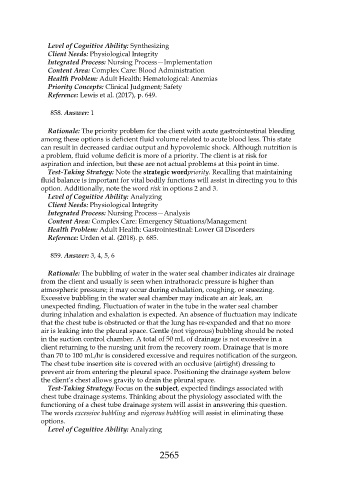Page 2565 - Saunders Comprehensive Review For NCLEX-RN
P. 2565
Level of Cognitive Ability: Synthesizing
Client Needs: Physiological Integrity
Integrated Process: Nursing Process—Implementation
Content Area: Complex Care: Blood Administration
Health Problem: Adult Health: Hematological: Anemias
Priority Concepts: Clinical Judgment; Safety
Reference: Lewis et al. (2017), p. 649.
858. Answer: 1
Rationale: The priority problem for the client with acute gastrointestinal bleeding
among these options is deficient fluid volume related to acute blood less. This state
can result in decreased cardiac output and hypovolemic shock. Although nutrition is
a problem, fluid volume deficit is more of a priority. The client is at risk for
aspiration and infection, but these are not actual problems at this point in time.
Test-Taking Strategy: Note the strategic wordpriority. Recalling that maintaining
fluid balance is important for vital bodily functions will assist in directing you to this
option. Additionally, note the word risk in options 2 and 3.
Level of Cognitive Ability: Analyzing
Client Needs: Physiological Integrity
Integrated Process: Nursing Process—Analysis
Content Area: Complex Care: Emergency Situations/Management
Health Problem: Adult Health: Gastrointestinal: Lower GI Disorders
Reference: Urden et al. (2018). p. 685.
859. Answer: 3, 4, 5, 6
Rationale: The bubbling of water in the water seal chamber indicates air drainage
from the client and usually is seen when intrathoracic pressure is higher than
atmospheric pressure; it may occur during exhalation, coughing, or sneezing.
Excessive bubbling in the water seal chamber may indicate an air leak, an
unexpected finding. Fluctuation of water in the tube in the water seal chamber
during inhalation and exhalation is expected. An absence of fluctuation may indicate
that the chest tube is obstructed or that the lung has re-expanded and that no more
air is leaking into the pleural space. Gentle (not vigorous) bubbling should be noted
in the suction control chamber. A total of 50 mL of drainage is not excessive in a
client returning to the nursing unit from the recovery room. Drainage that is more
than 70 to 100 mL/hr is considered excessive and requires notification of the surgeon.
The chest tube insertion site is covered with an occlusive (airtight) dressing to
prevent air from entering the pleural space. Positioning the drainage system below
the client’s chest allows gravity to drain the pleural space.
Test-Taking Strategy: Focus on the subject, expected findings associated with
chest tube drainage systems. Thinking about the physiology associated with the
functioning of a chest tube drainage system will assist in answering this question.
The words excessive bubbling and vigorous bubbling will assist in eliminating these
options.
Level of Cognitive Ability: Analyzing
2565

